Forum Replies Created
-
AuthorPosts
-
 Bill WardParticipant
Bill WardParticipantHi,
HROfft was written in the 90’s as part of a much longer Japanese meteor project, the Radio Meteor Observations. It is fully automatic so perhaps not as “flexible” as spectrum lab but that’s the very reason I like it. I first used it in 1998 but as today, it’s excellent bad weather insurance!
Once you get it set up and talking to Colorgramme it’s a case of leaving it alone. The only time I check the computer is if I see any odd results on the RMOB page!
The one downside is that because it’s designed to be left alone the thresholds are set quite high. It means that it’ll only record the strongest echoes. You can see this in the radiograms. 27 may be the count but there’s probably double that in actual echoes. Also it doesn’t have any way to discriminate against interference so the results can completely misleading if you have a noisy environment.
This is the main site run by Hiroshi : http://www.amro-net.jp/radio.htm
cheers,
Bill.
 Bill WardParticipant
Bill WardParticipantHi,
Great result. I always find the moonbounce remarkable to hear/see! (Grant, moonbounce is the term given to radio emissions that are emitted from the earth and reflected back from the moon. The Graves radar is so strong that when the moon passes through it’s beam the signal gets reflected back. If you’re running a meteor monitoring system you can see the echoes as a trace on the display. These reflections also changes frequency vary slowly over time, that is doppler shift, showing the motion of the moon about the Earth!)
It was solid clouds here also. The very high pressure may have settled the weather but the stratocumulus associated with such weather never broke up.
Ive attached a couple of traces from the peak showing the many reflections I got.
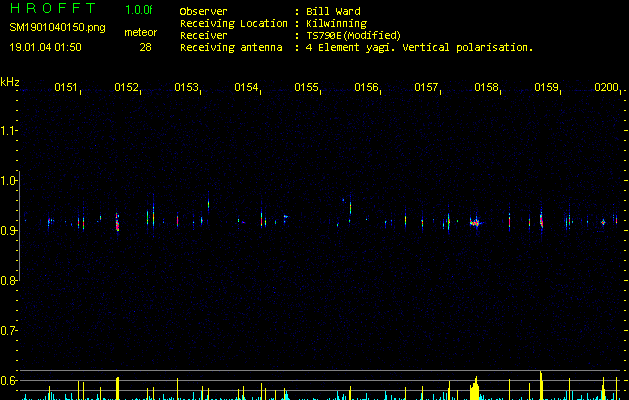
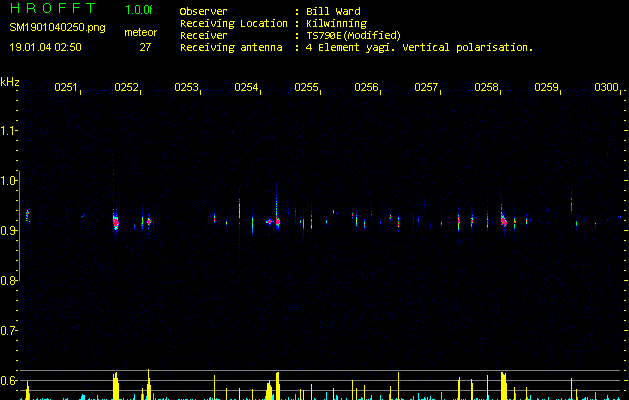
Very active for several hours.
Cheers,
Bill.
 Bill WardParticipant
Bill WardParticipantHi,
Thanks, I have always found it intruiging that, on varying scales, this is how we came to be. All that iron, magnesium, calcium etc that’s in us!
All the best for 2019.
Cheers,
Bill.
 Bill WardParticipant
Bill WardParticipantHi,
Thanks, Having caught quite a number of this type I was always on the lookout for a spectrum of one. They have definite mechanical/fragmentation properties and I was hoping it would be somehow different it spectroscopic composition. Maybe very high or very low in some element but it doesn’t seem so with what I have here. The other possibility is that there are some IR features (which I didn’t get with this example) that may show the differences. perhaps very strong O and H lines indicating the possibility some ice content….
However, it is yet another example of the power of this technique that we can even ask these questions!
Clear skies and all the best for 2019
Cheers,
Bill.
PS will you be attending the astrofest in February? perhaps we can meet for a drink.
 Bill WardParticipant
Bill WardParticipantHi,
That’s looking good. It is indeed an excellent start to the year. I had hoped the cloud would break for tonight’s Quadrantid’s but it’s looking absolutely solid. Not a breath of wind.
Cheers,
Bill.
 Bill WardParticipant
Bill WardParticipantYes, a few dedicated observers would use binoculars or even small telescopes in an attempt to get the best possible observations. I’ve caught a few meteors by chance through a small scope and it is quite a sight, I don’t know of anyone who does it now regularly as the technology has eclipsed the telescopic method. That was one reason I though it would be an interesting experiment, just to see how it would compare.
The software is UFO Capture, just as with wider field observing and if desired the files can be ran through UFO Analyser and UFO Orbit to determine orbits for shower id.
Magnitude wise I estimate +4 to +6 with the lenses I use. These magnitudes are where visual observations begin to become difficult if not impossible under suburban skies. The short track length also makes them difficult to pick up visually.
 Bill WardParticipant
Bill WardParticipantHi,
My apologies, the plot seems to be missing from my original post, that was rather the point!
Here it is….
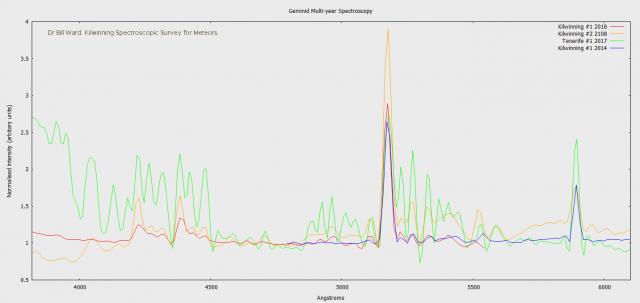
Bill.
PS, EDIT. OK now I am confused, it seems ok on this PC, perhaps there is a browser issue?
Computers!
 Bill WardParticipant
Bill WardParticipantFrom inside, a nice catch, qudos for leaving a camera running!
What software do you use to control the camera? I used to use Nikon cameras but have gone wholesale with Canons for astronomy. Is it suitable for Canon’s?
Cheers,
Bill.
 Bill WardParticipant
Bill WardParticipantHi,
I use the free spectroscopy package Visual Spec. It is much better than Rspec AND you don’t get stiffed for 100 bucks every time they decide to update it. Note, for legal reasons I stress this is my opinion only… 😉
Cheers,
Bill.
 Bill WardParticipant
Bill WardParticipantMmmm, could be, the time is spot on however the direction on cam 8 is quite a bit to the south azimuth wise. If I get time I might do a manual run through with UFO Orbit. I’ll keep you posted (Or if any other observations pop up….)
Bill.
 Bill WardParticipant
Bill WardParticipantHi,
The weather here was extremely poor on the 8/9 so thank goodness for the radio observations! Saw a nice clear peak on the radio. Tweeted a few graphs but they could still do with some tweaks. 10 min bins loses some of the general form and hourly bins lose the detail, might try 30min counts….!
In any case the peak rate with me was between 0000ut and 0100ut with a total count of 138 meteors (Draconids plus any others) Entirely subjective manual counts from the HROfft captures, so probably a few +/- throughout . A good result though.
Would’ve been nice to have have had a peek at the shower visually.
cheers,
Bill.
 Bill WardParticipant
Bill WardParticipantHi,
I am relieved, put it down as another success for my comparative meteor spectroscopy method…!
The power of the spectrum!
cheers,
Bill.
 Bill WardParticipant
Bill WardParticipantHere’s the frame I used to extract the spectrum. The star field can be identified by Dubhe, brightest star lower left. The actual meteor would be ~30/40mm off the edge of the frame on this scale. I hope someone else has it because I’d be surprised if this pans out to be a Perseid, it doesn’t fit the profile…. but you never know!
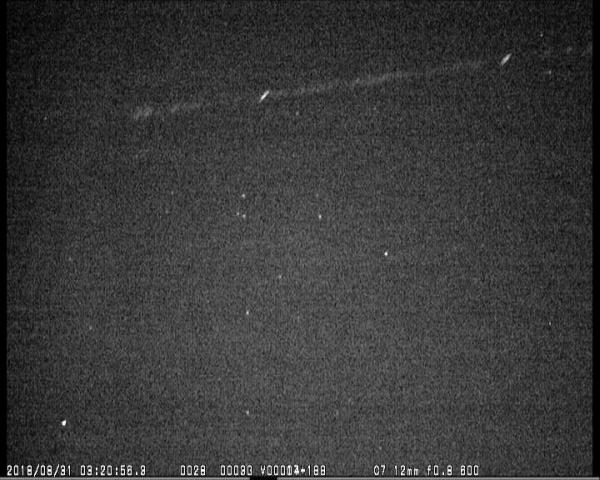
 Bill WardParticipant
Bill WardParticipantHi,
Regarding space junk, I’m not sure. The fact that the spectrum had a set of the near IR atmospheric lines suggests it was doing a fair clip. All of the re-entry video’s and spectra I’ve seen have been relatively slow (and horrendously complex!) Whilst the most prominent metal lines are certainly Mg and Ca there are weak Fe features which are in the background of most spectra. No guarantee but I’d put my money on it being a tiny bit of something natural.
Cheers,
Bill.
 Bill WardParticipant
Bill WardParticipantHi,
I was hoping you’d catch something with your N facing camera. However even considering the diffration angles involved I don’t think that was the one. I’m on a different machine at the moment but I will double check.
cheers,
Bill.
 Bill WardParticipant
Bill WardParticipantHi,
An excellent summary of the problems! As strategies evolve one of the things I continue to do (after the “discovery” of the rapid changes in spectrum of the bright Perseid, 2013) is to examine the spectrum videos frame by frame. This is in an effort to mitigate some of the very noise and absorption issues you mention. By taking the shortest possible “length” of spectrum to sum up to get a viable spectrum. The best, of course only need one frame but on others you need to use longer temporal sections.
I have been saying for years that meteor spectroscopy is a tricky proposition analytically speaking. There are a few published papers by Jeniskens that discuss “quantitative” spectroscopy but without some assumptions I’m not fully convinced (maybe I just don’t understand the maths!)
Nobody knows any physical information about the particular meteoroid that produces a particular spectrum beforehand and THAT is the problem. EVERY other aspect of the meteor we then capture is entirely random. Time, position, duration, luminous efficiency (and that’s the big one…) etc.
All we can determine with any certainty is the geocentric velocity, then comes along a spectrum carrying all these observational variables, did I mention tricky… ;-))
I think this is one of the reasons that the technique of comparing particular line ratio’s (as devised by Borovicka) is about as good as we can get.
HOWEVER even with qualitative results significant differences is spectrum characteristics can be identified and I think that’s why sporadics are the most interesting proposition and what I’ve called Comparative Meteor Spectroscopy can get us into some sort of new taxonomy over the coming years as data builds up.
Observers have been conducting meteor spectroscopy for a lot longer than me but these programs caught large fireballs on rare occasions but I think I’ve been the first to do regular video meteor spectroscopy, (in the UK?), and that’s only been since 2008 (or 2006 if you include my very first tests). So we’re only just starting a new field. Another 10 years and we’ll have a whole new picture of what’s in our planets neighbourhood.
All we can do is work with what we’ve got…
cheers,
Bill.
 Bill WardParticipant
Bill WardParticipantWell if they’re driven EXACTLY in phase they’ll either both be open or both be closed. If driven exactly out of phase it’ll look either always open or always closed. If the drive signal is allowed to drift they’ll strobe in and out of phase. If that’s not what happens then I’ve no idea!
 Bill WardParticipant
Bill WardParticipantHi,
Some objective perfomance,
First pic is the LCTec shutter running at 20Hz. The upper trace is the photodiode output. You can see how it is twice the frequency of the driving signal, lower trace.
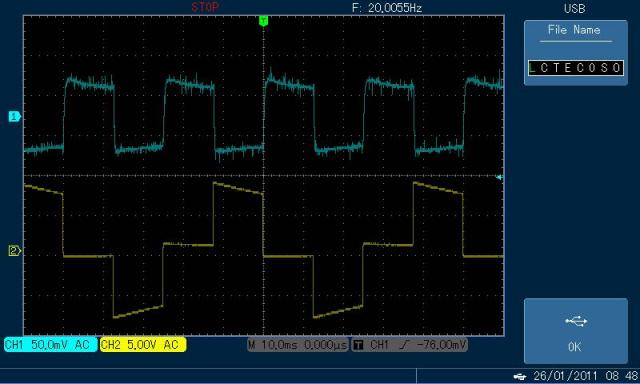
The second picture is what I reckon is the best performance of the smaller, cheaper shutter. It only has the upper trace. Ignore the frequency on the image, the scope is picking up some of the much higher frequency noise. The drive signal was 6Hz giving 12 breaks/second.
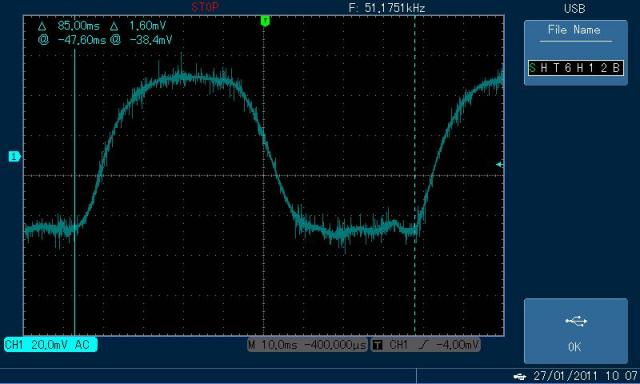
You can see the photodiode output is much more rounded. This would translate into a “softer” edge to the segments of the meteor image. This might actually be ok for slow meteor measurements but probably just for purely aesthetic effect (and, rather usefully, differentiation between satellites and meteors!), we’ll see…
(The “delta T” is given as 85ms between the cursors. So working backwards gives a drive frequency of 5.9Hz so I don’t exactly have the cursors one pulse apart.)
cheers,
Bill.
Just noticed, 2011, I need to reset my clock!!!
 Bill WardParticipant
Bill WardParticipantYUK! Hi hopes dashed! Much truth in the expression ” you get what you pay for”!
My ultra cheap LCD shutters arrived today. They work quite well at 5 Hz
By 10Hz things are going down hill.
I imagine they’d work after a fashion but the trail would not be as clean as the LCTec FOS.
At £2.95 for the 36mm square one and £4.95 for the 48mm x 98mm ( which is actually pretty big), not too expensive an experiment.
I’m going to mount the smaller one in front of a camera anyway and see how it goes. Be interesting to see a side by side comparison. All I need is some clear sky, that’s the big ask!
Cheers,
Bill.
 Bill WardParticipant
Bill WardParticipantHi, I use the same basic method with my WATEC’s however when you dig into the numbers even 1/25 sec isn’t fast enough to get the required precision to determine decelerations for orbital corrections. Steve Evans’ paper from 20 years ago (!!!) out lines the requirements nicely. (JBAA Vol 108 4 1998 “Experiments in digital meteor astrometry”) His work then was with his rotating shutter system, which I have and am trying to reinstate, running with three blades giving a chopping interval of ~33.3ms that’s faster than 1/25 sec (40ms) and it still wasn’t enough. He ultimately was working with a 6 blade shutter to give ~16.7ms (Which is the one I’ve been given). Astrometrica is the program he mentions.
The costs are high but not prohibitively so compared to the camera’s your using. Even with the cost of a LCD shutter and function generator as they are at the moment is still ~tenth of a SONY A7SII and if you include include a cheap dslr and lens and you’ll get five systems for the money. Despite all of the limitations with meteor observing it’s all about sky coverage!
I’ve found a supplier of very cheap LCD shutters and have ordered a couple to experiment with. IF these work then it becomes extremely feasible to have a high speed optical chopper that may yield arcsec precision for less than £20 (if you build a function gen kit from ebay!)
The consumer technology is quite remarkable.
-
AuthorPosts
